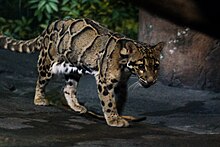Neofelis nebulosa
| Clouded leopard | |
|---|---|
 |
|
| A clouded leopard at the Cincinnati Zoo and Botanical Garden | |
| Scientific classification | |
| Kingdom: | Animalia |
| Phylum: | Chordata |
| Class: | Mammalia |
| Order: | Carnivora |
| Suborder: | Feliformia |
| Family: | Felidae |
| Genus: | Neofelis |
| Species: | N. nebulosa |
| Binomial name | |
|
Neofelis nebulosa (Griffith, 1821) |
|
 |
|
| Clouded leopard range | |
| Synonyms | |
|
Felis macrocelis |
|
Felis macrocelis
Felis marmota
The clouded leopard (Neofelis nebulosa) is a wild cat occurring from the Himalayan foothills through mainland Southeast Asia into China. Since 2008, it is listed as Vulnerable on the IUCN Red List. Its total population is suspected to be fewer than 10,000 mature individuals, with a decreasing population trend, and no single population numbering more than 1,000 adults. The clouded leopard is the state animal of the Indian state of Meghalaya.
The scientific name of the clouded leopard is Neofelis nebulosa. It is one of two members of the genus Neofelis, and is classified under the family Felidae. It was first described by the British zoologist Edward Griffith in 1821. The other member of this genus is the Sunda clouded leopard (N. diardi), which was considered a subspecies of N. nebulosa until 2006.
The clouded leopard is part of the Panthera lineage, one of the eight lineages of Felidae. This lineage comprises the species of Panthera and Neofelis. The Neofelis species diverged first from the lineage, followed by the snow leopard. Genetic analysis of hair samples of the two Neofelis species indicates that they diverged 1.4 million years ago, after having used a now submerged land bridge to reach Borneo and Sumatra from mainland Asia. Subsequent branching in the lineage is disputed. Broadly, two different cladograms have been proposed for the Panthera lineage.
The clouded leopard is considered to form an evolutionary link between the big cats and the small cats. It represents the smallest of the big cats, but despite its name, it is not closely related to the leopard.
...
Wikipedia

